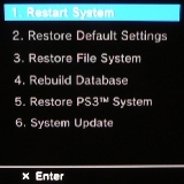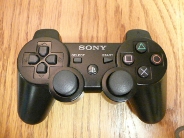YLOD Repair Guide
If your system is under Warranty do not attempt this repair! Send your system to Sony for repairs!
YLOD(Yellow Light of Death) - Overview
YLOD is refered to by Sony as a general hardware failure. While this is true, and the YLOD can result from several different problems, most people experience this error as the result of the console overheating to the point that it damages the solder points on the CPU and/or GPU.
This problem is identified when you turn the console on and you first see the led on the front of the console turn green, then it briefly changes to yellow and finally changes to blinking red.
Disclaimer
SEMPERTHREE in no way guarantees that your system will be repaired using this process and requires users of this guide to read and accept our disclaimer that is provided on our main repair page.
A Note About this Repair
While this YLOD repair seems to work most of the time, SEMPERTHREE does not recommend this as a permanent repair for your system. We have fixed several YLOD consoles using these techniques with varied results. Most of the systems we have repaired have lasted a minimum of 15 more hours of playtime before the repair had to be done again or we simply scrapped the system. I do, however, have one system that has been running for six months now.
Based off of our results we have mainly used this repair to be able to go in and recover data and deactivate systems. If however you are like us and do not mind that you may need to open the system again to do another YLOD repair of the same nature then you could keep and use the system you repaired.
Repair Guide by gilksy aka colinjester
This repair for YLOD was come up with by "gilksy". All credit for this repair goes to gilksy for his excellent work and development of this repair technique. Due to the nature of this repair we recommend that you be at least somewhat tech savy and be a good DIY type of person. Basically, if you can build your own computer you should be able to handle performing this repair.
The YLOD repair consists of the full disassembly of the console down to the board level and uses a standard heat gun to "reflow" the solder joints to the CPU and GPU. The written guide, video and PDF file below will walk you through the entire process and cover all necessary details of the repair. This guide was developed using a 60gb model, remember that other models may be slightly different to disassemble.
Fluxing the BGA's
If this is the first reflow on the console you are working on, then fluxing is generally not necessary as the solder still should contain enough flux for a good reflow. If however your system has needed to be reflowed a second or more times you will probably need to flux the BGA's in order to acheive positive results from the reflow.
Please check out our PS3 BGA Fluxing page with another great video provided by gilksy, for instructions and information about fluxing your board.
Tools and Materials
- #2 Phillips
- #1 Phillips
- T-10 Torx Security screwdriver or a small flathead screwdriver.
- Heat Gun capable of 350oC/662oF
- Thermal Paste - SEMPERTHREE recommends Arctic Silver 5.
- Paper towels or a clean rag to clean up old thermal paste.
- Isopropyl Alcohol for thermal paste cleanup. Other cleaners may be substituted.
- Vacuum or canned air to clean case and system of dust.
Written Instructions
SEMPERTHREE recommends reading the instructions and watching the videos before you begin any work on your console. When you are ready to start the repair, you should download the PDF and print it to use as a guide while you do the repair
1. Remove warranty sticker and rubber foot that’s positioned above hard drive bay.
THIS WILL VOID WARRANTY FROM SONY!
2. Using a small flat blade screw driver or slotted torx bit, unscrew cover plate screw.
3. Slide cover plate towards the left until it stops and lift off.
4. Remove all Phillips screws marked noting size and position.
5. Hinge case towards you until disengaged and then tilt towards the left. See below.
6. Remove ribbon cable by carefully lifting black part of connector (locking tab).
7. Lift/tilt blue ray drive towards the right whilst disconnecting power cable and the large ribbon (lift tab) underneath.
8. Remove 5 screws and the earth wire screw on psu, and unplug
connector plug.
Before removal of psu unplug small bnc connector (black wire) and
remove tape on side of psu, now lift off psu.
9. Now remove the wide ribbon from connector (lift tab) unscrew the four screws on the Bluetooth board and remove.
10. Remove hard drive cover.
11. Unscrew blue hard drive screw and disengage hard drive by sliding towards gap in the bay.
12. Remove hard drive, see below.
13. Unscrew 4 screws holding the bracket, on/off and eject control panel. Remove small ribbon (lift tab) and remove control panel.
14. Unscrew 8 screws.
15. Lift enclosure out of plastic base, see below.
16. Now unclip black rear panel and remove.
17. Unscrew 4 screws and remove sprung brackets, see below.
18. Lift of metal cover plate whilst allowing ribbons to pass through gaps in plate without damage, see below. (Taking note where heat sink rubbers are positioned).
19. Supporting fan assembly turn board over, remove fan power connector and fan.
20. Remove 2 screws holding plate to hard drive connector and unplug battery connector. Now remove plate.
21. Clean off old heat sink compound from the 2 mainprocessors using Isopropyl alcohol making sure all traces of the old heat sink compound has gone.
22. Clean both touch plates on bottom of fan/heat sink assembly with Isopropyl alcohol until all traces of the old heat sink compound has gone.
23. Now using a vacuum cleaner or compressed air blower get rid of all dust build up in the case and on all component parts of the ps3 (pay special attention to the fan assembly and heat sink fins(MUST BE CLEAR OF DUST).
24. Typical example of dust build up.
Ps3 case (dusty).
Heat sink plates before
heat sink compound removed (dusty).
25. Once cleaned you should now have a nice pile of bits that looks something like this, see below. Now for the tricky bit!
26. Check the top metal cover plate (underside) for burn-in marks, as you can see below this ps3 got very hot before it yloded!
27. Place the ps3 mother board on a flat heat resistive surface (kitchen work top or melamine shelf will be fine).
28. Turn heat gun on and set temperature to 350 deg and the fan speed to low (to high and it will move the surface mount bits).Allow gun to get up to temperature before continuing!
29. Using a circular motion hold heat gun over areas outlined below (keep heat gun an inch above board/components at all times).
30. CPU side first.
31. After 15 to 20 seconds move onto the next area.
32. Once all marked areas have been heated/reflowed on the mother board LEAVE for at least 10 to 15 minutes to cool. (DO NOT MOVE MOTHER BOARD WHILE COOLING).
33. A popping noise may be heard during cooling, don’t worry this is normal.
34. NON CPU side.
35. After 10 to 15 seconds move onto the next area.
36. Once all marked areas have been heated/reflowed on the mother board LEAVE for at least 10 to 15 minutes to cool. (DO NOT MOVE MOTHER BOARD WHILE COOLING).
37. A popping noise may be heard during cooling don’t worry this is normal. Heat sink compound still on in this picture, remove before reflowing. Heat sink rubber pads still on in this picture remove before reflowing also hold ribbons out of way while reflowing
Congratulations!!
You have just repaired you’re ylod ps3 mother board.
38. Now its time to apply new heat sink compound to the 2 processors, when doing this its always best to follow the manufacturers instructions but I believe the process is the same with all types (please check instructions that come with paste), before continuing
39. The paste I am using is called AKASA 450 it’s a silver based compound with a thermal conductivity of 9.24w/m deg c and an operating range of 0 to 200 deg c. You can buy it from most pc shops but I get mine from my local Maplin ( I have been told that there is a better compound on the market called arctic silver but I haven’t tried it as yet so the choice is yours).
40. Use syringe supplied and dispense a small worm of compound from top to bottom on the left hand side of processor chip, now using credit card supplied spread compound evenly and thinly over processor face (to much is bad and not enough is also bad) the ideal amount is when you can almost see through the paste.
41. Now repeat on the other processor.
42. See below.
NOW IT IS TIME TO REASEMBLE THE PS3. RETRACE YOUR STEPS IN REVERSE TO REBUILD MAKING SURE ALL RIBBON CABLES HAVE BEEN FULLY INSTERTED INTO CONNECTORS AND LOCKED DOWN IE. (TABS).
Video Guide
PS3 YLOD Repair Guide by gilksy - PDF format
If you found this guide useful and would like to donate. Please follow this link to gilksy's youtube channel and you will find a link there to donate directly to gilksy for his excellent work and continued research into the PS3.






